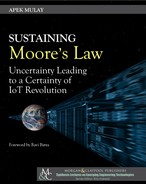9.7. REFERENCES 59
revenue for this industry). As long a semiconductor industry’s progress complies with a sustain-
able macroeconomic progress, progress of Moore’s Law beyond 50 years can continue to benefit
the semiconductor industry and global economy. Today, Moore’s Law needs to be redefined for
sustainable macroeconomic progress for the progress of the law.
In my book Mass Capitalism: A Blueprint for Economic Revival, I have mentioned one of
the five important features of this free-market theory of Mass Capitalism as:
“Time and space are changing, and the semiconductor industry will have to adjust with
those changes. e principles of mass capitalism will not change; rather the application of
these principles will have to adjust with the changing circumstances. e semiconductor
industry will have to move forward by recognizing and adjusting with changes in time
and space.”
Based on this feature and for sustainable macroeconomic progress, Moore’s Law should also
adjust to changes in time and space. Hence, for a predictable business model for the semiconductor
industry beyond 50 years of Moore’s Law, Moore’s Law needs to be redefined. Moore’s Law could
be re-defined as:
“e macroeconomic policies should establish a true free-market economy in the U.S. semi-
conductor industry such that the continued growth in the number of transistors per square
inch on integrated circuits grows in proportion to the consumer purchasing power in the
economy, to ensure a sustainable consumption of the manufactured electronics and sustains
the increased demand for more electronics. is shall ensure that doubling the number of
transistors on integrated circuits would continue into the foreseeable future.”
9.7 REFERENCES
[1] Andrei A. Kirilenko and Andrew W. Lo, “Moore’s Law versus Murphy’s Law: Algorith-
mic trading and its discontents,” Journal of Economic Perspectives, Volume 27, Number 2,
pp. 51–72, Spring 2013.
[2] David C. Brock, Understanding Moore’s Law: Four Decades of Innovation, Chemical Her-
itage Foundation. Philadelphia, PA, pp. 122, 2006.
[3] Hutcheson, Dan G., “Moore’s Law: e History and Economics of an Observation that
Changed the World,” Electrochemical Society Interface, pp. 17–21, Spring 2005.
[4] Huff, Howard (Ed.), “Into the Nano Era : Moore’s Law Beyond Planar Silicon CMOS,”
Springer Series in Material Science, Vol. 106, Series ISSN0933–033X, pp. 11–35, 2009.
[5] Moore Gordon E., “Lithography and the Future of Moore’s Law,” SPIE Speech, 1995.
[6] Mulay, Apek, Mass Capitalism: A Blueprint for Economic Revival, Book Publishers Net-
work. Bothell, WA, 2014.
60 9. MOORE’S LAW BEYOND 50
[7] Mulay, Apek, “Moore’s Law Will Not Come to an End Anytime Soon,” LinkedIn. March
15, 2014.https://www.linkedin.com/pulse/20140315035003--11893233-moore-
s-law-will-not-come-to-an-end-anytime-soon?trk=mp-reader-card
[8] Mulay, Apekshit, “50 Years of Moore’s Law - Chips Off the Old Block,” e Economic
Times, Apr 18, 2015. http://epaperbeta.timesofindia.com//Article.aspx?eid=
31815&articlexml=50-YEARS-OF-MOORES-LAW-Chips-Off-the-18042015008037
..................Content has been hidden....................
You can't read the all page of ebook, please click here login for view all page.
